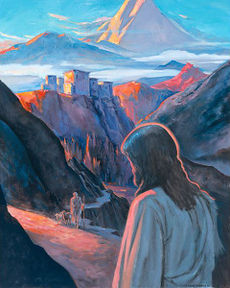Lost years of Jesus
There is no record in the Bible of Jesus’ whereabouts between the age of twelve, when he was in the temple in Jerusalem discoursing with the rabbis, and age thirty, when we see him at the River Jordan being baptized. Those intervening years—the so-called “lost years”—are the most important years of Jesus’ life because in those years he became who he was and prepared himself for his Palestinian mission.

Jesus was probably born between 8 B.C. and 4 B.C., spent his early life in Palestine, and may have moved to Memphis, Egypt, shortly after his birth and lived there for three years. Many legends from the British Isles say that his great-uncle Joseph of Arimathea, a tin merchant with a fleet of ships, regularly sailed to the British Isles and took him to Glastonbury as a youth, between ages seven and twelve, to be educated at the Druid universities, which were flourishing at that time.
We see him next in the temple at age twelve on the occasion of the Passover and then we hear of him no more in the Bible until the age of thirty. Scholars have assumed that he was living in Palestine during that time, occupied as a carpenter. However, there are absolutely no facts to support that theory.
Evidence from Buddhist manuscripts
Ancient Buddhist manuscripts that say Jesus spent those “lost years” in the East. These texts were originally recorded in Pali, the sacred language of the Theravada Buddhist canon. Later they were translated into Tibetan. The manuscripts were discovered in November 1887 by Russian journalist Nicolas Notovitch at Himis, this Buddhist monastery near Leh, Ladakh. In 1894, Notovitch published a translation of those texts as The life of Saint Issa.
According to the manuscripts, at age thirteen Jesus departed Jerusalem with merchants and set out towards the Sind “with the object of perfecting himself in the Divine Word and of studying the laws of the great Buddhas.” At age fourteen he crossed the Sind, a region in present-day southeast Pakistan in the lower Indus River valley. He then established himself among the Aryas.
Jesus’ fame spread and the Jains asked him to stay with them. But he went instead to Juggernaut, India, “where the white priests of Brahma made him a joyous welcome.” The priests “taught him to read and understand the Vedas, to cure by aid of prayer, to teach, to explain the holy scriptures to the people, to drive out evil spirits from the bodies of men, restoring unto them their sanity.” Between the ages of fourteen and twenty Jesus spent six years at Juggernaut, Rajagriha, Benares and other holy cities.
Eventually, Jesus became embroiled in a conflict with the Brahmins and Kshatriyas (the priestly and warrior castes) because he taught the holy scriptures to the lower castes. His enemies plotted to kill him. And at age twenty-one he left Juggernaut by night and went to the foothills of the Himalayas in southern Nepal, the birthplace of Gautama Buddha. Between the ages of twenty-one and twenty-seven Jesus spent six years in Nepal, where he mastered the Pali language and became “a perfect expositor of the sacred writings.”
According to tradition, sometime during his sojourn in the East Jesus also traveled to Ladakh, Rajputana and Kabul in present-day Afghanistan. Between twenty-seven and twenty-nine he left the Himalayas and journeyed West, preaching along the way. He passed through Persia, where he rebuked a false priesthood of Zoroastrianism, who in turn cast him out of their town in hopes that he would fall prey to the wild beasts. Finally at age twenty-nine, fully prepared for his mission, he returned to Palestine.
Significance of the lost years
In those lost years Jesus walked a path of discipleship under the great lights of the East. He sought the perfecting of his heart and mind, and although he was born an avatar, he still had to take the necessary human footsteps. Jesus had to walk the path to accomplish his soul’s integration with the Word in preparation for his baptism, his transfiguration, crucifixion, resurrection and ascension, and he had to work to internalize and bring forth the fullness of his Christhood. And if he had to do it, we also have to do it.
El Morya points out that the suppression by the churches of the knowledge of Jesus’ lost years has “hurt the younger generation more than all others, because they have had no one to equate with from the years twelve to twenty-nine. In those very important years from twelve to eighteen, when all of the burdens and temptations of life come upon them, they have not seen the figure of the one who became the master and who now is ready to show them the way.”[1]
See also
For more information
Elizabeth Clare Prophet, The Lost Years of Jesus: Documentary Evidence of Jesus’ 17-Year Journey to the East
Sources
Elizabeth Clare Prophet, October 4, 1987.
Elizabeth Clare Prophet with Annice Booth, Mary Magdalene and the Divine Feminine.
- ↑ El Morya, Pearls of Wisdom, vol. 25, no. 70.
